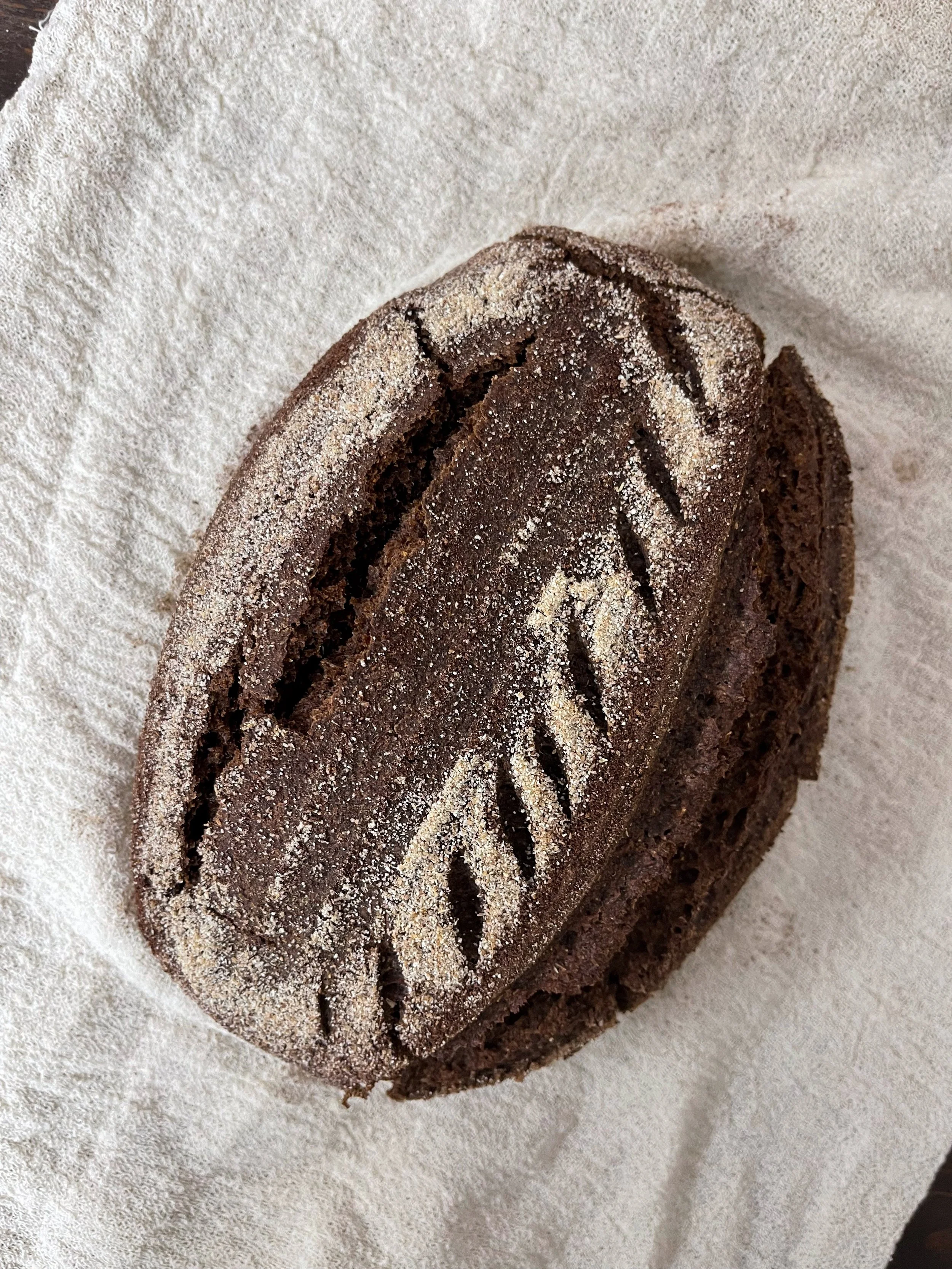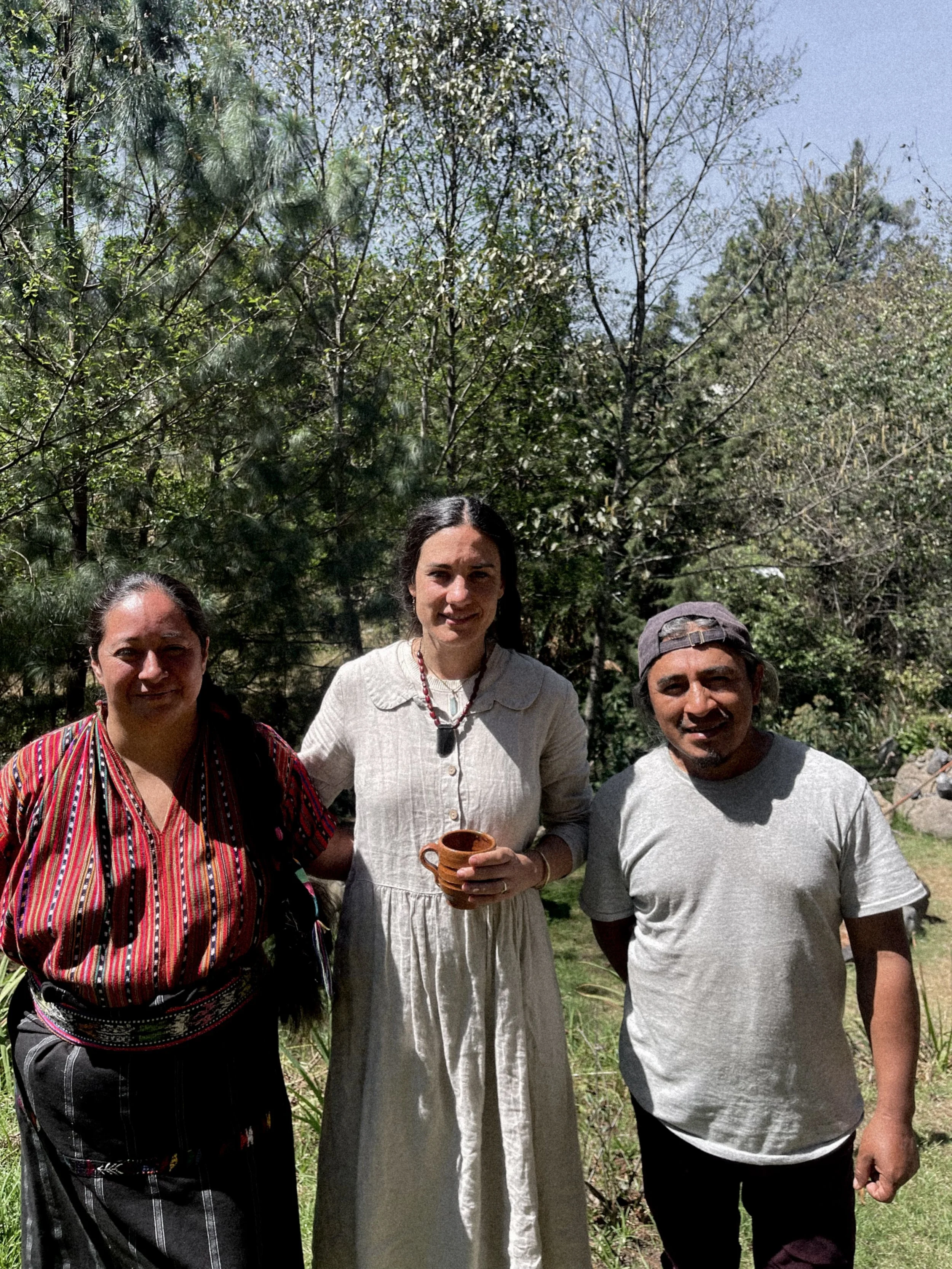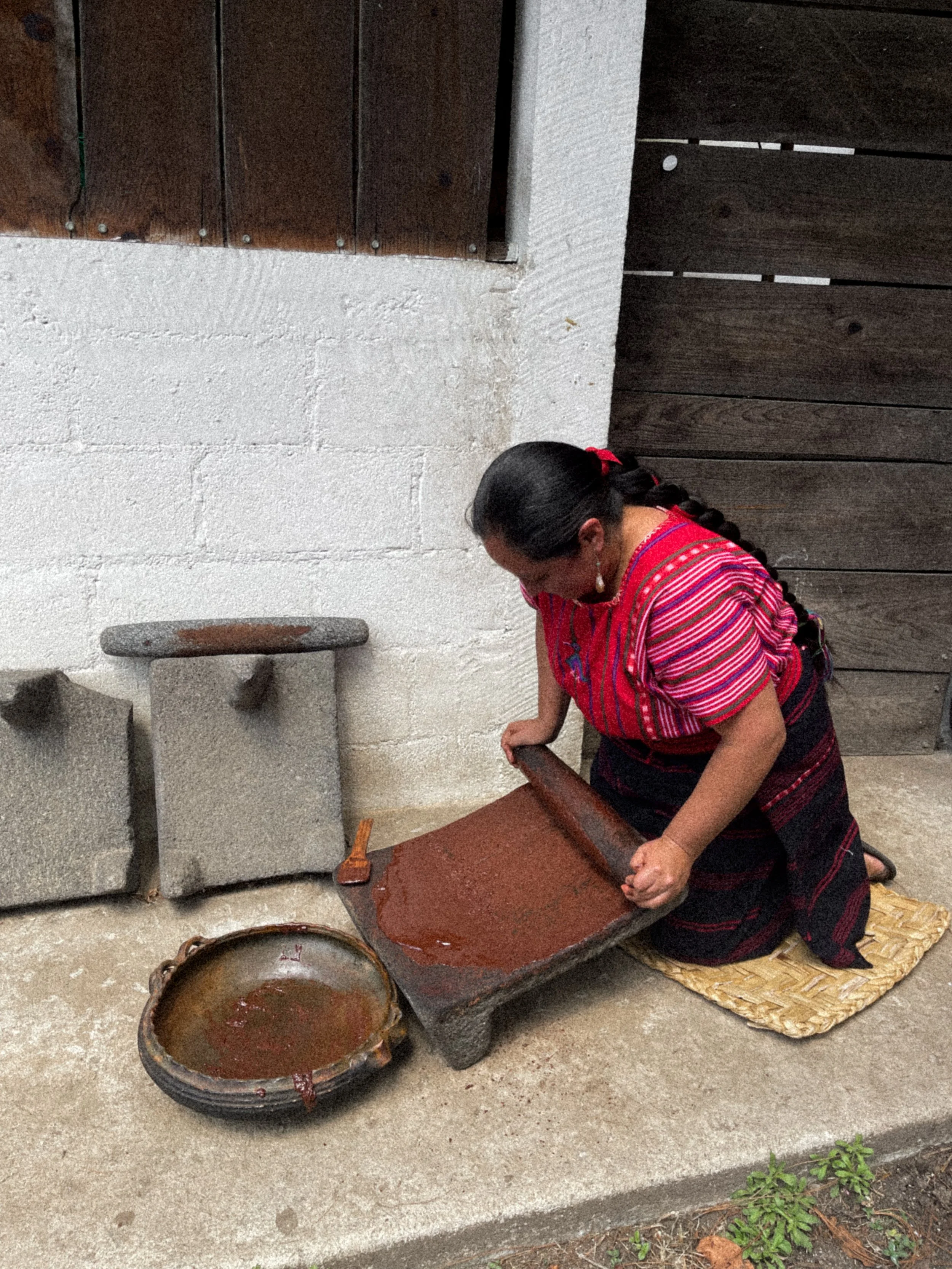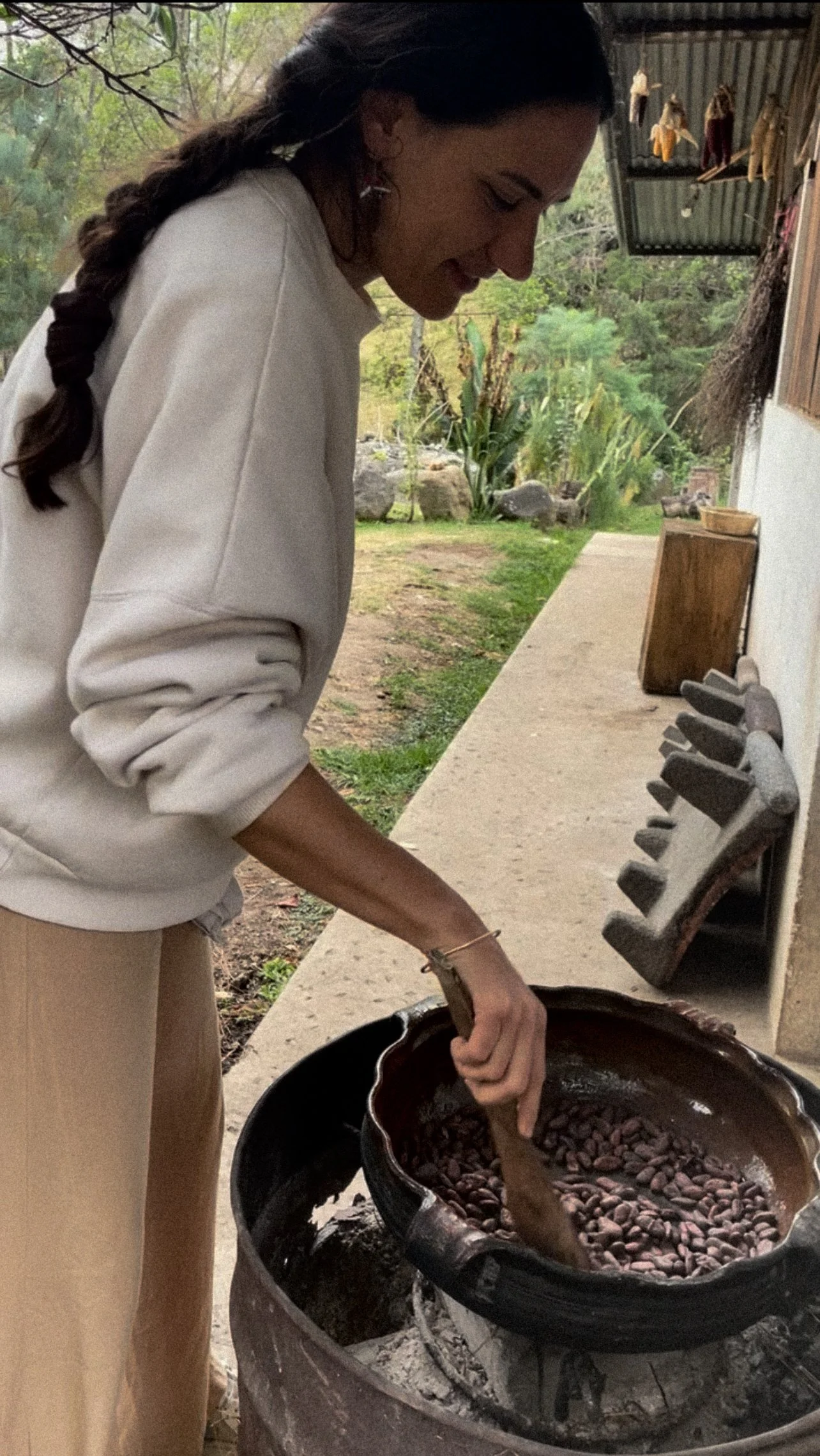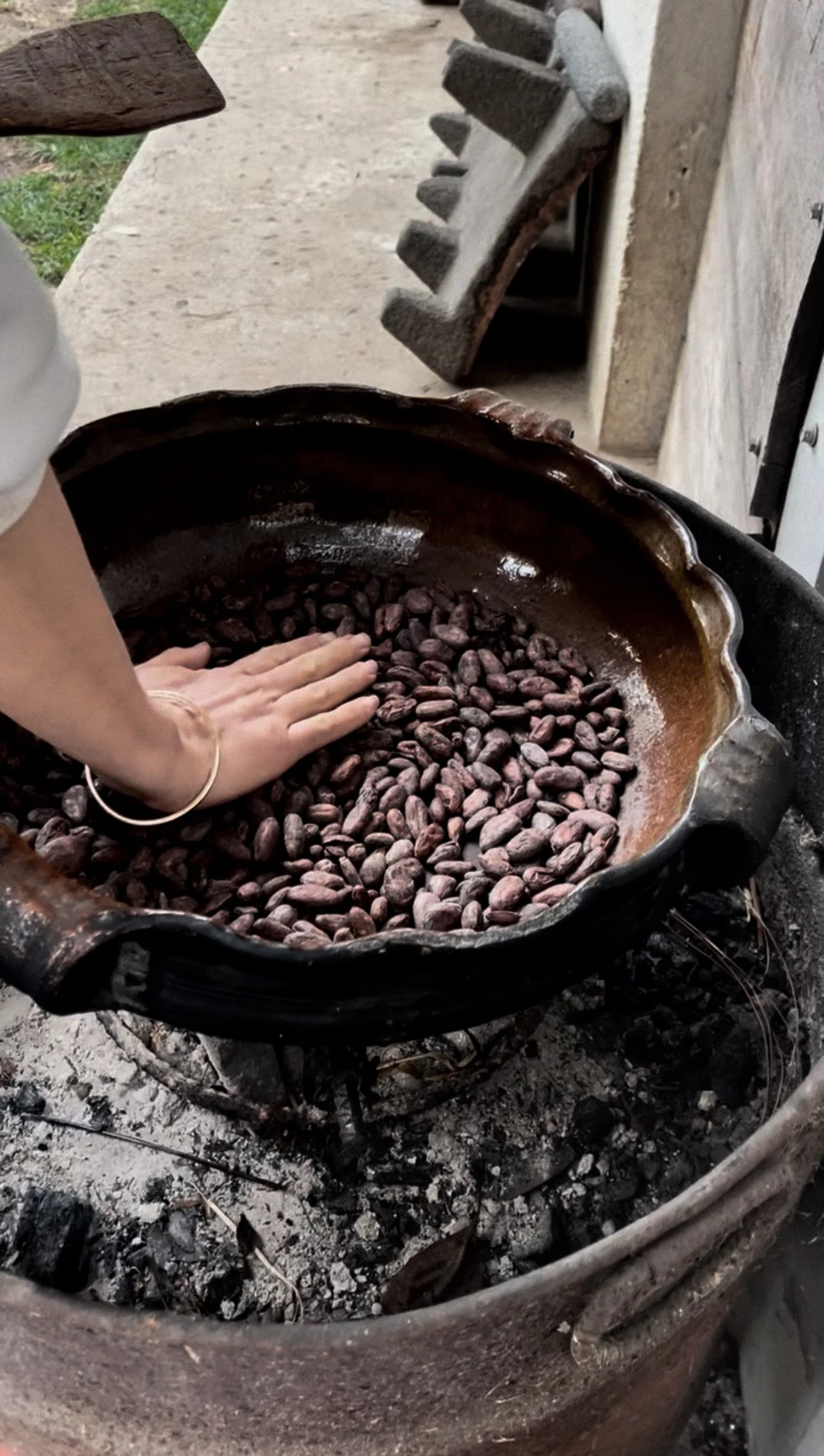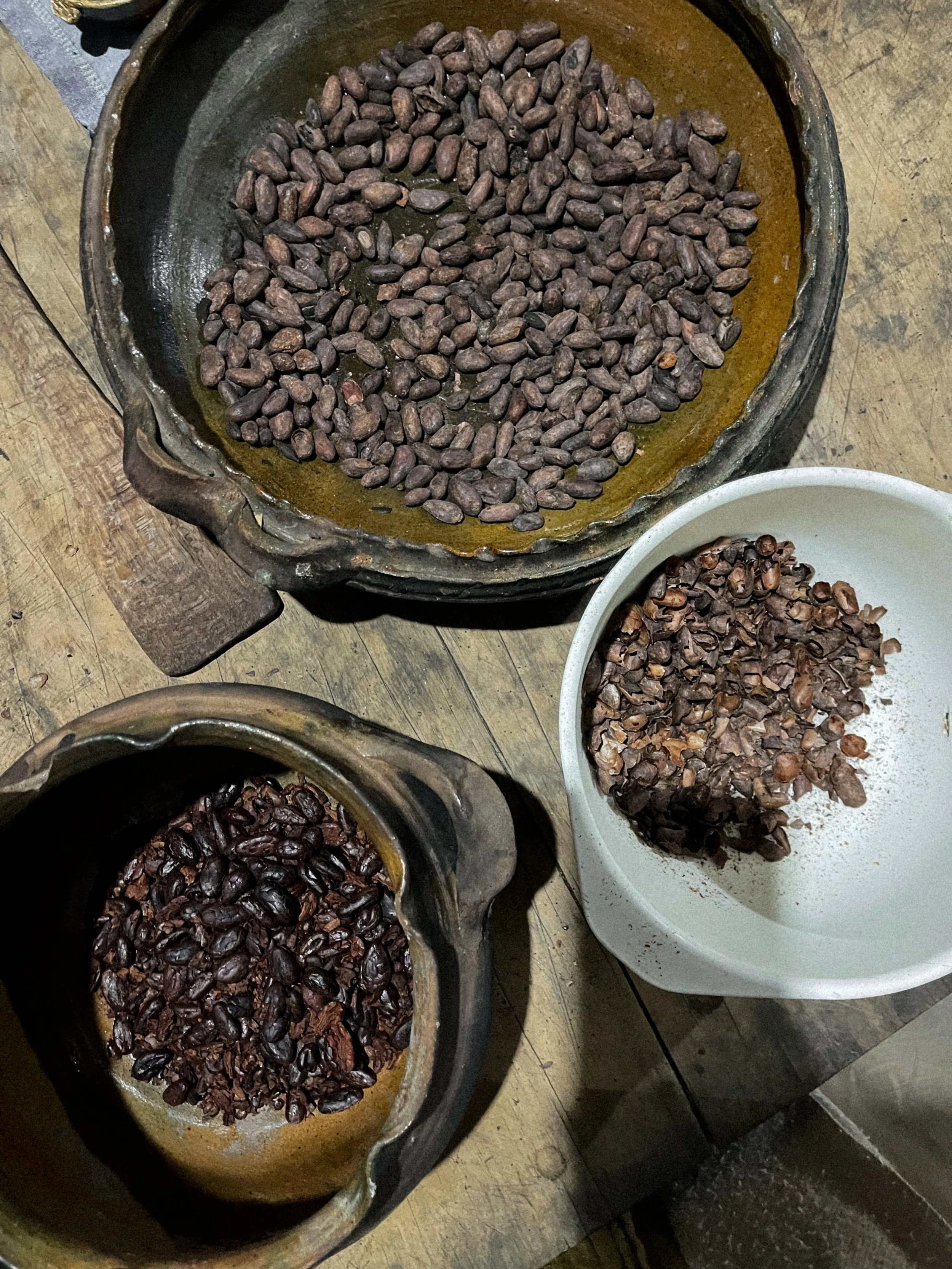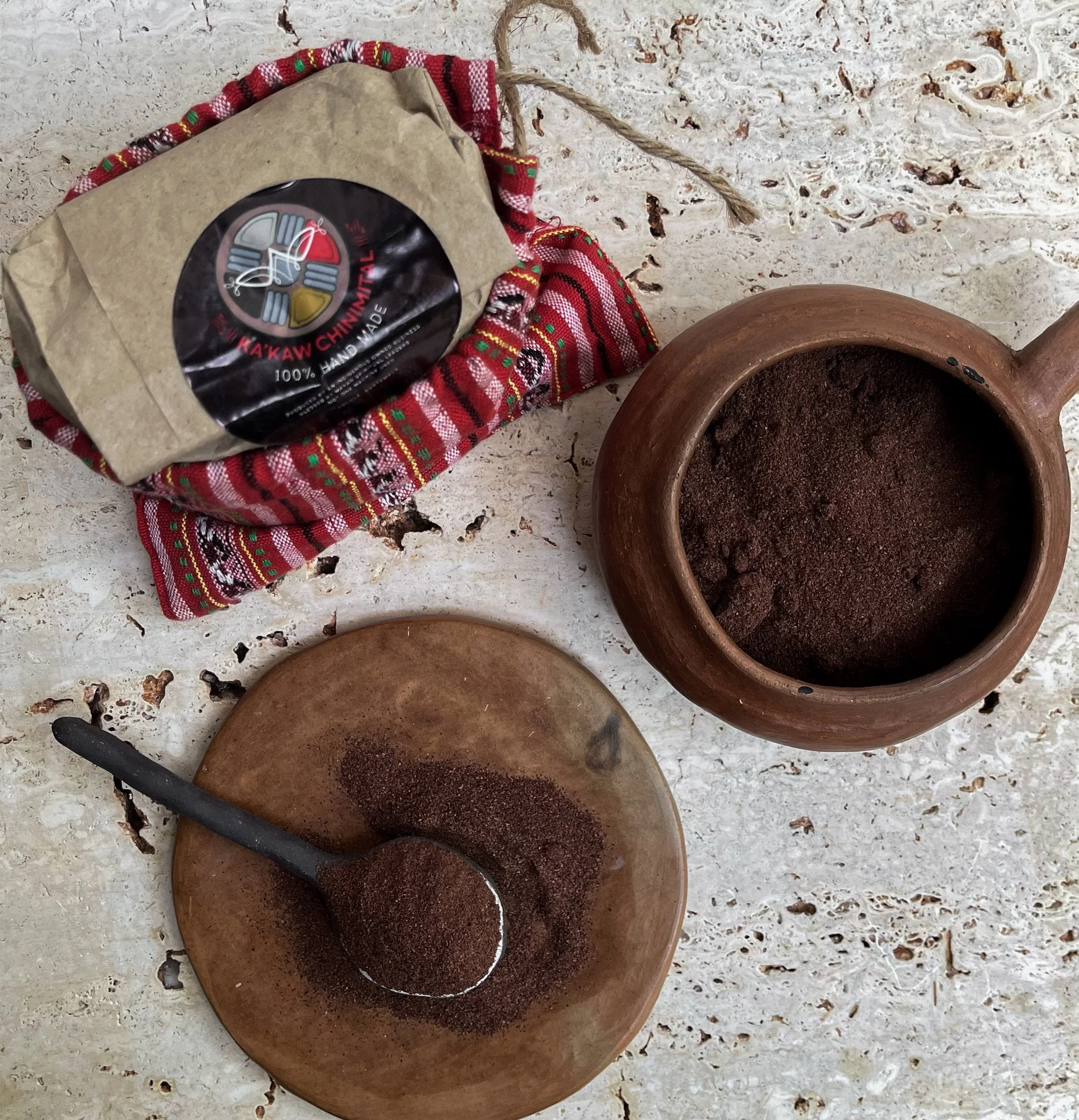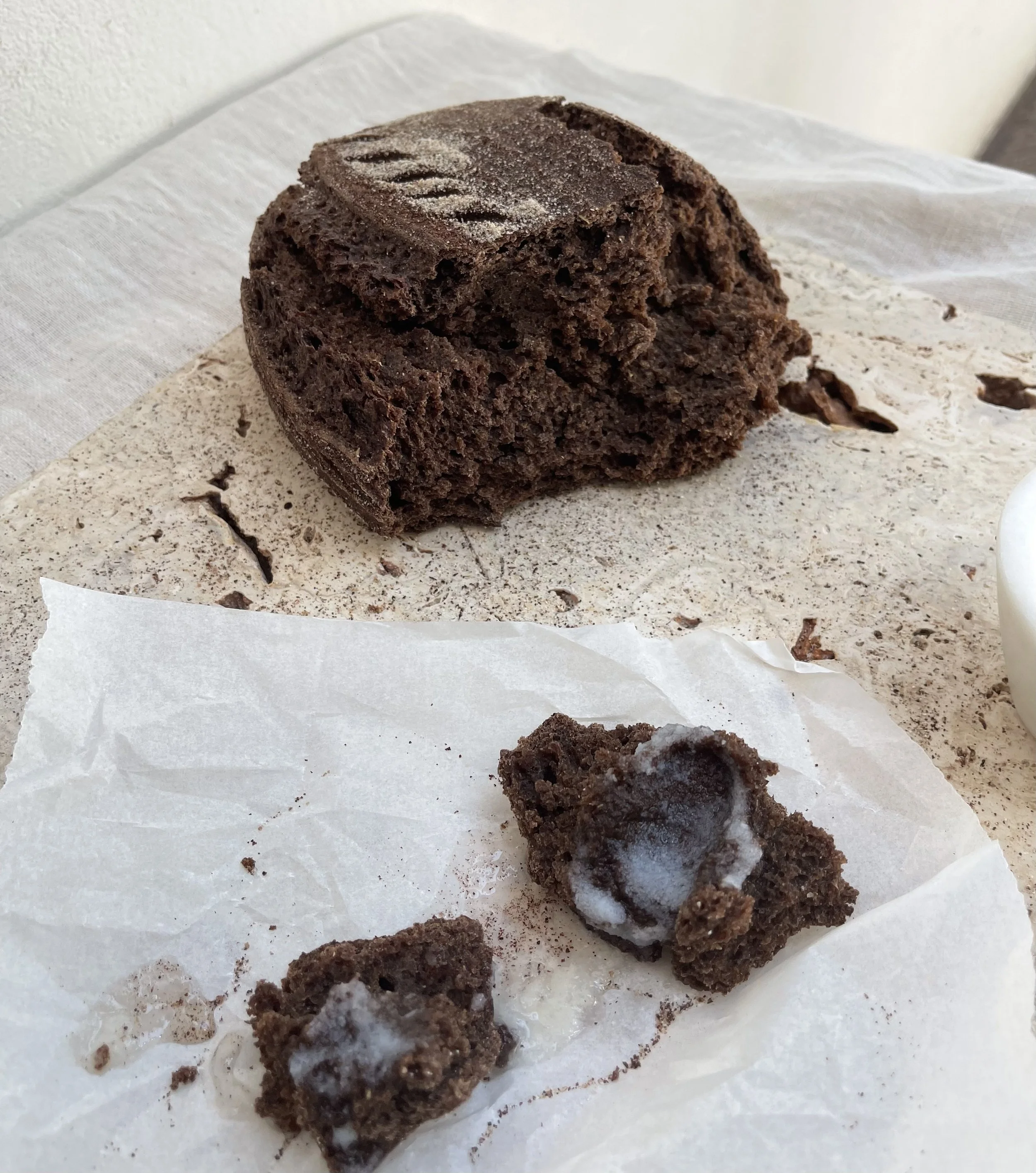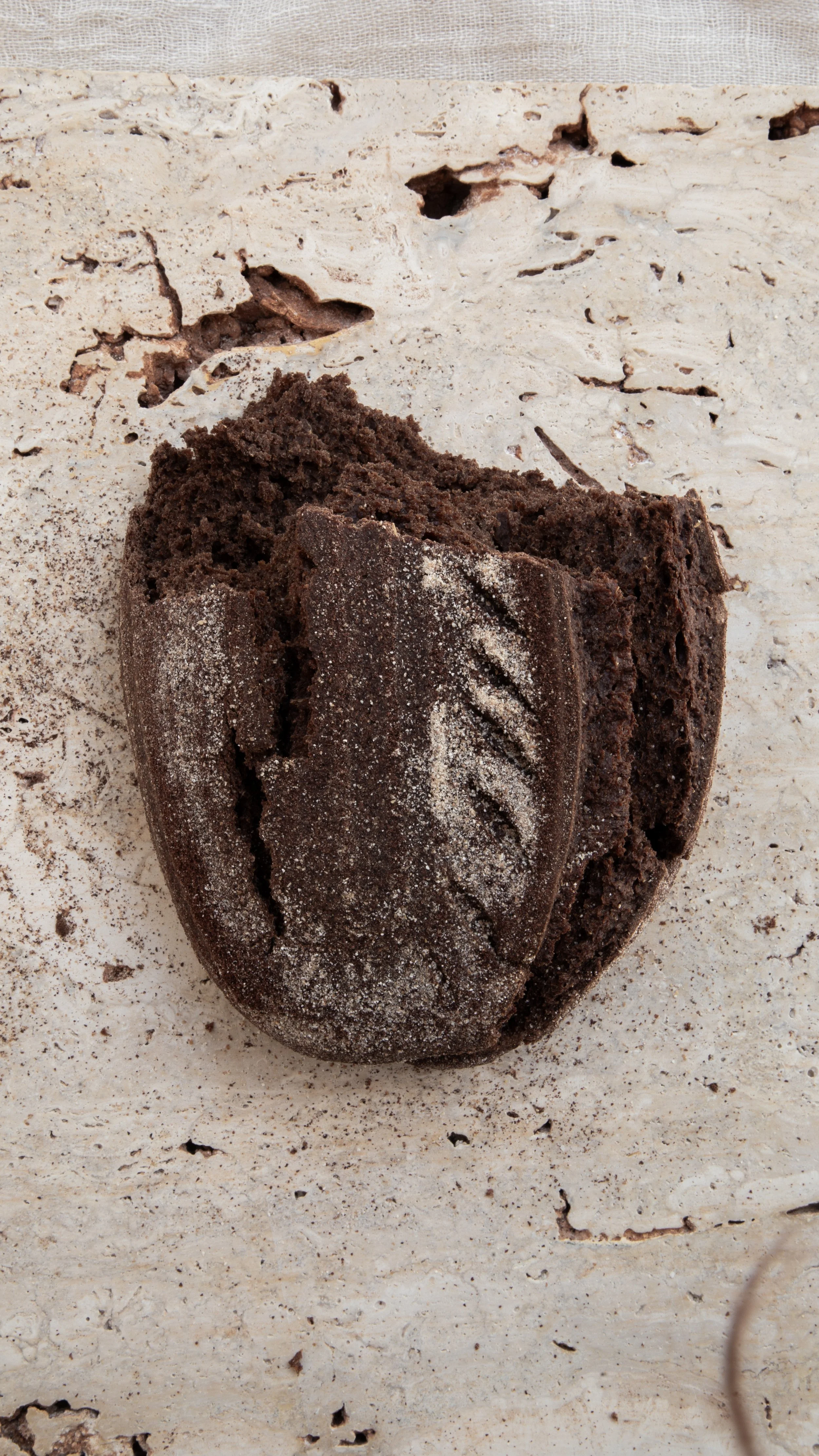KAKAW EMMER SOURDOUGH LOAF
Last February, I went on a sacred journey to Guate Maya (the original Mayan name of the country known with the colonial name Guatemala) to meet the crafters of Kakaw Chinimital and their community. The essence of their cacao called me to meet and be on this land and to connect to the culture and Mayan Cosmovision around cacao (aka kakaw) on a deeper level planting the seeds for the future.
The sacred family that is processing and making the ceremonial cacao Kakaw Chinimital is part of a broader community where the Mayan descendants are returning back to their roots living according to the values and teachings of the Mayan Cosmovision. Close to nature, in houses made with natural materials, on the piece of land that hosts their subsistence crops as well as medicinal herbs and homestead animals throughout the year.
With Nana Jessica and Tata Jerico, guardians of ancestral cacao knowledge and wisdom, from Kakaw Chinimital on their homeland, the last day before departure.
Nana Jessica, guardianess of ancestral cacao, grinding peeled cacao beans to the ceremonial grade cacao paste in the traditional Mayan way with the ‘metate’ (the name for the grinding stone).
Their community was remarkable of its potential and self-sufficiency with the medicine men and women, the ones responsible for the grains and the seeds of the community, the cacao, everyone working and exchanging in reciprocity under a community system where everyone is working not only for their families but mainly to offer their services and gifts within their community.
It is so beautiful and powerful to see members of every ancestral civilisation around the world rising and reclaiming their cultural heritage and identity that had been silenced due to colonialism.
By the end of my stay I was gifted the amazing cacao tea they are making from cacao husks. The cacao husks are the outer skin of the cacao bean that peels off when the cacao bean is toasted. In the process of cacao paste making, the toasted cacao bean has to be peeled in order to remove the cacao husk which was usually discarded. The cacao husk is hard and quite acidic from the fermentation of the cacao bean, although it still carries a rich cacao aroma.
Not only are they full of aroma but also cacao husks are packed with antioxidants that neutralise free radicals in the body. Moreover, they are full of theobromine that induces the production of endorphines and other ‘happy’ molecules responsible for the positive mood boost and a sense of heart opening, love for the self and for the others around us.
For this reason, the whole cacao husks are the perfect ingredient for warm infusions or they can be used in bread making, other baked goods or patisserie when they are ground to a thin flour like powder.
In this way, the cacao husks from waste are turned into a very useful and flavourful ingredient supporting the zero waste management of cacao processing.
Toasting cacao beans over fire the traditional Mayan way. One of the main requirements for ancestral ceremonial grade cacao paste.
Testing the temperature of toasting the cacao beans by hand over fire.
In the process of peeling the toasted cacao beans. Clockwise from top; toasted cacao beans, cacao husks, peeled cacao beans.
Cacao husks are still having the full aroma or cacao bean and at the same time they add some bitterness and acidity to the products because of the prior fermentation of the cacao beans and the flavour profile of cacao.
For this reason, I intuitively chose the emmer wheat to go with it to match its texture, earthy grounding flavour and ancestral essence.
Diving deep into her flavour. It is a whole new discovery of the depth of the senses. A weaving of the ancestral essence of emmer wheat, the crunch, the flavour and the scent of sacred cacao. One of my favourite loafs so far!
Here she is for you to enjoy! This is an advanced recipe relevant to the ones who have practiced with the sourdough bread making. Alternatively, you could add some finely ground cacao husks to a bread recipe with yeast fermentation you might be more familiar with. In case you are in Greece and you want to learn more about sourdough bread making join one of the Sourdough Bread Rituals that I will be hosting this autumn!
Finely ground cacao (aka kakaw) husks by Kakaw Chinimital.
Pieces of kakaw emmer wheat sourdough loaf with local goats butter and finely ground sea salt .
KAKAW EMMER SOURDOUGH LOAF
INGREDIENTS (makes one loaf of bread)
220 g emmer wheat flour
65 g ancestral (einkorn) flour
48 g cacao husks (aka. cacao tea), finely ground
90 g sourdough starter, activated
265 g filtered water, lukewarm
2 tablespoons (tbsp) carob syrup
6 g sea salt flakes, finely ground
EQUIPMENT
+ a bowl large enough to mix the ingredients and knead the bread // preferably a heavy ceramic one or glass
+ a glass container for liquids or jar with a minimum volume size of 500 ml
+ a scale and a wooden spoon
+ a bread rising basket and a linen or cotton towel large enough to cover the basket
+ baking tray + oven
+ your beautiful creative hands
Optional: to enhance the baking process: a cast iron Dutch oven or a baking stone or steel with an oven dish on top deep enough to cover the bread without touching it.
PREPARATION
In the bowl, combine the flours together with the finely ground cacao husks and mix well, using your hands or a wooden spoon.
In the glass container, combine the lukewarm water with the carob syrup and the activated sourdough starter.
Mix well using a wooden spoon to an homogenous solution.
Slowly pour the sourdough solution to the flours. Mix with round movements - using your hands.
Intensify the kneading and continue mixing the dough until all flour is hydrated and well incorporated in a sticky dough. Don’t worry if it is too sticky… this is emmer wheat! Due to its low gluten content it will be stickier and harder to get the dough off your hands.
Cover the dough with a wet towel and let her rest for at least 30 minutes.
After that time, uncover the dough and spread half the quantity of salt evenly on the dough. Fold the dough one time and repeat the seasoning with the rest of the sea salt. Fold the dough again a couple of times to ensure that the salt is well incorporated in the dough. If some salt is still visible, sprinkle a tiny bit of water (1 tablespoon) to melt it and fold again.
Knead the dough using your hands. Notice how it feels now. How has the texture and sensation changed?
Continue kneading the dough for a few more minutes.
Let her rest for 20 minutes and repeat the folding again. Repeat the cycle of resting and kneading two more times. After that, fold the dough by creating some flexible tension and transfer her in the basket that you have previously sprinkled with a blend of emmer wheat flour and finely ground cacao husks.
Let the loaf rest on the bench at room temperature for about one hour to rise.
Transfer her in the fridge overnight for about 8 to maximum 12 hours.
The next day, take her out of the refrigerator at least one hour before baking.
Preheat your oven at 230°C (conventional heating) together with the dish you have chosen in order to enhance the baking process. If you dont have a baking dish this is also ok!
Bake the bread covered for 15-20 minutes in preheated oven.
After this time, lower the temperature to 210°C, uncover the bread and bake her for another 15 minutes until dark brown.
If you are not using a cast iron dish for baking your loaf, just follow the same process as mentioned above and ignore the part of uncovering the bread. In this case consider reducing by 5 minutes the duration of each baking interval.
Let the loaf completely cool on a cooling rack before slicing it.
Serve with the Hazelnut Cacao, honey and butter or tahini paste.
TIP: If you desire a sweeter loaf, add a few more tablespoons of carob syrup in the recipe and adjust the water content accordingly.
I hope that you enjoy fully the process of making!
Much love,
Alexandra
A hand pinched loaf :)
